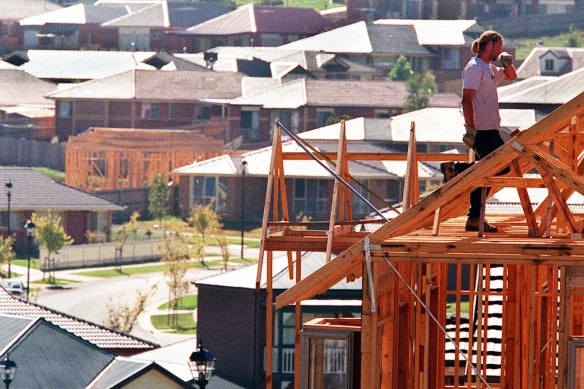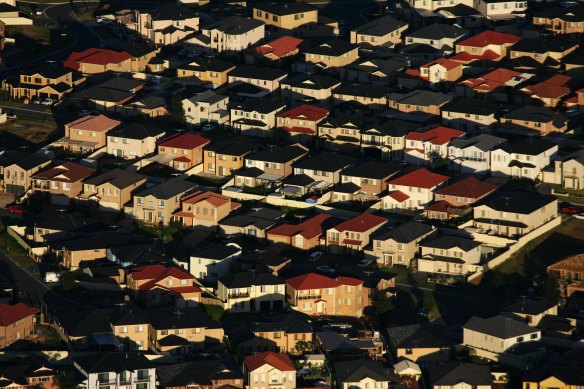This was published 1 year ago
Opinion
To save suburbia, we’ll need to destroy much of it
Tone Wheeler
Australian Architecture Association presidentAustralia loves suburbia. We are the most suburbanised OECD nation: more than 40 per cent of the population in two extended cities, 70 per cent in 10. But as I’ve written before, we’re ruining that suburban dream by building houses twice as big on blocks half the size, devoid of gardens and trees, further from city centres and amenities, and with fewer residents in each home. So what might we do about it?
We don’t need to swallow more land to build new houses. Rather, we should build infill housing in existing areas. These homes include granny flats, duplexes and triplexes, “low and close” multi-dwellings on amalgamated sites or undeveloped land, and apartments or co-living projects such as shop-top housing within walking distance of public transport.

Where to build and how many?Credit: Joe Armao
If done cleverly, the additional dwellings can enhance the quality of suburbia, not detract from it. Instead of bloated dark-roofed McMansions that squeeze out gardens, infills should be modest in scale and size, with photovoltaics on white roofs and room for trees to reduce energy demand and the “urban heat island effect”.
The suburban dream established at the turn of the 20th century became a nightmare at the turn of the 21st. Fixing this mess is our No. 1 planning priority, but while the prescription may be easy, taking the medicine will be politically hard, as it runs into the twin shibboleths of property development and “NIMBYism”.
Building and infrastructure represent the biggest employment and economic activity in Australia’s gross domestic product, shading mining and agriculture by a factor of two. But voters hate all development, so builders lobby government hard. Not only are we NIMBYs (not in my backyard), we are NOTEs (not over there either). In our glass castles, we’ve become CAVE dwellers (citizens against virtually everything).
We revile developers, but the irony is most Australians are developers themselves: 65 per cent of households own a house, 20 per cent two or more properties, and all regard their houses as “an investment in the property market” as much as being homes.
More housing supply is the developers’ mantra. But is it real? Arithmetically not, as there are more dwellings in Australia (almost 11 million) than households (9.8 million). On paper, we have enough to house everyone, except more than one million homes are second or holiday houses. Banning short-term letting could solve the problem of providing housing for everyone, but since that would be politically risible, we will have to build at least 100,000 new homes every year.
Continued expansion of suburbia is the easy go-to answer for both developers and politicians when the issue of new housing supply is raised, but new outer suburbs, such as those proposed south-west of Sydney at Wilton, or in the north-west of Melbourne, are pure developer greed. No services, schools, hospitals or public transport, and miles from employment centres. Unsustainability on steroids that has bedevilled the Andrews government and will bedevil whoever wins the NSW election.
Ending fringe suburbia will infuriate land speculators, who gamble on rezoning to gain windfall profits without adding any value. Worse still, this greed corrupts the political process. State governments could end speculation by buying land at fair value for its current zoning before it is rezoned. They could then set the value of the land and benefit from the “uplift” to pay for the infrastructure needed, and hopefully make restitution to local Indigenous groups whose country it is.

Not quite a blank canvas, but the challenge is to reimagine our existing suburbs.Credit: Nick Moir
The better approach is to build those 100,000 houses within our existing suburbs. The question is how many where? The answer is to seek an ideal density of “dwellings per hectare”, which is a measure of efficiency and sustainability within which people can access services. The most sustainable density has the Goldilocks principle: 10 is too spread out to be efficient; 100 requires too much energy-hungry equipment; 40 dwellings per hectare is just about right.
Advocacy groups such as Save our Suburbs will resist these changes, in effect saving the physical fabric while destroying liveability and affordability. By contrast there are so many clever ways to design infill housing that would be more accessible, more affordable, address the needs of diverse households and improve sustainability and the environment.
What do those ideas look like? Different strokes for different folks.
The granny flat: This is one popular solution, without a big loss of space and privacy. It creates a multi-generational house. It might, indeed, be a home for granny, but perhaps it becomes a “garden studio” for the difficult Year 12 student or adult children who want to stay at home while saving for their own. It might be a source of income, collecting rent from students or locally employed essential workers. This flat may be best placed in the front yard rather than the back. Councils are far too precious about the visual quality of very ordinary streetscapes, without regard to amenity and sustainability for the residents. Maybe a carport for the extra cars required, but with a studio on top.
More houses on the same site: Larger sites in older areas often have smaller houses, but councils may enforce some ludicrous heritage order. It could be a timber cottage (old but decrepit) or a Federation house. We don’t have to keep them just because they were built when the founding fathers (as they were) hammered out the White Australia Policy. The politics were wrong and the houses not much better. Relax the front setbacks and allow duplexes or triplexes to be built, still with reasonable setbacks. The “ziggurat” envelope can be very useful in ensuring the built form allows for solar access to neighbours without a loss of privacy. Both NSW and Victorian governments have programs, but you can drive a monster McMansion through the controls.
Low-rise apartments along existing tram, train or bus lines are called transport-oriented design, or TOD. Urban designer Rob Adams calculates Melbourne’s population could be doubled using only 7.5 per cent of the city area as TOD, with three and four-storey “shop-top housing” along existing tram lines. Sadly, the new metro lines in the north-west corridor of Sydney fail to capitalise on TOD possibilities. The design for Rouse Hill shopping mall is surrounded by car parks, a six-lane road and a vast cemetery keeping apartments at bay. At Schofields and Riverstone, apartment buildings are miles from the centres while low-density housing is close.
Age in place: We need to let older Australians remain in familiar territory. One way could be by subdividing or subletting their house, to share with family members or others. Minimal changes could yield big benefits if planning and tax laws encouraged it. Another way is to move to an apartment with better support services in their suburb. Over the past 20 years on Sydney’s leafy North Shore, residents fought tooth-and-nail to prevent four- to six-storey apartment buildings being built along the Pacific Highway. Only when they were built did they discover the huge demand from local families, releasing their houses for others but allowing them to remain close to the friends, clubs, societies, shops and services they had known for most of their lives.
We need to encourage people to change their homes as their needs change, which brings us to the evil of:
Stamp duty. Stamp it out. As it stands, a one-off stamp duty of many tens of thousands for a new home is a reason for older Australians not to leave their existing one. So abolish that tax and replace it with an annual payment, paid much like local council rates. Premier Dominic Perrottet has got this ball rolling for first home buyers, but I’d extend it to all – and calibrate the level of the annual tax according to the home’s contribution to sustainability. People should be encouraged to sell to downsize as they grow older or their needs change, or to upsize into a multi-family home, to look after the children and grandchildren who can’t afford their own.
Less tax, more trees: There is already a greening program for Western Sydney to alleviate the urban heat-island effect created by thousands of dark roofs, dark bitumen, and paved areas, older suburbs. What if there was a tax break if you planted trees, or vegetable and fruit gardens, or took in a lodger?
But we are making a hash of it by not building the higher-density housing at the beginning. We need to learn from the Canberra conundrum where low-density suburbs were fully developed while the land that was set aside for “future medium-density housing” was undeveloped. Residents became so accustomed to the open space that they protested vehemently when that housing was being built. It was soon bastardised to resemble the Torrens title bonanza elsewhere.
We need radical new approaches to save suburbia from itself.
The Opinion newsletter is a weekly wrap of views that will challenge, champion and inform your own. Sign up here.